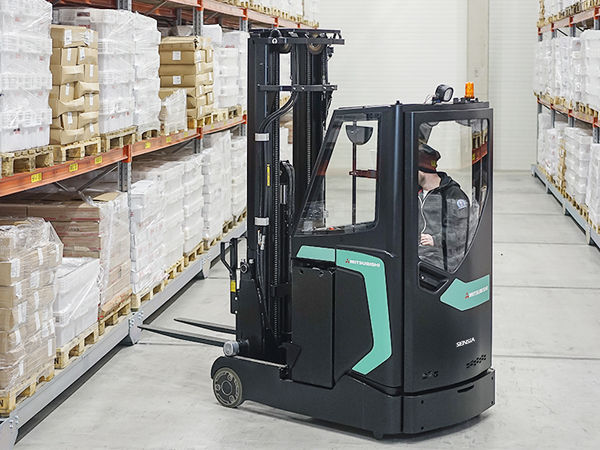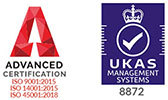It’s important that you understand the difference between a forklift and a reach truck. Where they look very similar and sound as though they should, pretty much, do the same thing, they actually vary greatly with regards to their capabilities and the jobs they can handle.
Whether you’re looking to carry considerably heavy loads with little-to-no manual involvement from your staff or simply wish to train your employees so that they’re safe behind the wheel of heavy machinery, it’s paramount that the differences between the two pieces of equipment are made evident. So what is a forklift, what is a reach truck, exactly?
What is a forklift?
A counterbalance forklift is the most common type of forklift on the market. It’s also the most popular with warehouse owners thanks to their sheer versatility and wide range of fuel types.
Forklifts can be used both inside and outdoors, making it perfect for premises that are spread across two sites.
Forklifts, as the name would suggest, adorns two very large forks that protrude from the front of the vehicle. There’s also a closed cabin at the top that offers all round visibility for forklift operators to enable the forklifts to be navigated as safely as possible whilst also protecting the workers on the ground.
Forklifts are generally used for lifting heavy pallets and other large, heavy or misshapen loads. Despite them being driven on small tyres, they’re extremely versatile when it comes to travelling across loose, uneven or rough terrain. This can sometimes depend on the material the tyres are made from. Typically they’re either made from rubber or polyurethane, with the latter being a bit stronger than the former.
Counterbalance forklifts can lift loads up and down as well as transport them across vast spaces as and when needed. Regardless of the size of your warehouse, a forklift will make short work of operations. For more compact spaces,
VNA forklifts can be used as they’re able to effortlessly navigate around narrow aisles and tight areas.
Electric forklifts or
LPG forklifts would be ideal for warehouse owners who are looking to reduce their carbon footprints, whereas
diesel forklifts are powerful, high-performing machines that make them ideal for use outdoors. The forklift type you go for really does depend on the industry you work in, the nature of the products you handle and size of your premises.
Conventional forklifts can only move loads up and down in a smooth motion, so they shouldn’t be confused with
telehandlers that can move loads forwards and backwards as well as upwards and downwards.
There are also a wide range of
forklift attachments available that can transform your forklift almost into an entirely new machine. This way, you’ll be able to use your forklift for far more than just handling heavy loads – another reason why they’re so popular within the material handling industry.
What is a reach truck?
A
reach truck looks very similar to a conventional forklift, however, the differences are profound. As the name would suggest, this piece of material handling equipment has an extended reach compared to a counterbalance forklift. With this in mind, a reach truck will then be able to delve deeper into the racking in order to access stock, regardless of its weight, size and shape.
A reach truck is able to retain stability by using robust legs that act as a counterbalancing weight, much like a counterbalance forklift. This means that an internal weight is not needed, which is something that’s present on older pieces of lifting equipment, including forklifts and reach trucks.
The capabilities of a reach truck really does differ depending on the make, model and age you go for. Where a new reach truck would perhaps offer more advanced technology a
used reach truck would probably be just as powerful, but without all the bells and whistles – something many warehouse owners require.
Due to the impressive level of stability a reach truck has, it makes it exceptionally flexible when it comes to catering for lifting and handling operations in and around the warehouse; making it ideal for use regardless of the industry you’re in and the nature of the stock you handle.
If your warehouse racking reaches up to 10m tall, then you’ll find that even the most state-of-the-art forklifts will fail to reach heights of this calibre, but you’ll always be able to count on a reach truck to access inventory at this level. A reach truck is ideal for those who are looking to maximise the space they have throughout their premises, all without having to move to a larger warehouse or invest in additional property.
Much like a forklift, there are models out there that are suitable for both indoor and outdoor use, making them the best possible solution for warehouse owners whose premises are spread across two or more sites. You won’t have to worry about whether or not they can tackle loose, rough or uneven terrain because they’ll make short work of tackling many different types of terrain in a safe manner.
Multy Lift are pleased to provide customers throughout the country with new material handling equipment and used warehouse equipment. Whether you need a new or second-hand reach truck, pallet trucks, order pickers and more, Multy Lift will have you covered.
Multy Lift are material handling specialists with extensive knowledge and expertise to draw upon. We pride ourselves on helping warehouse owners across the country, regardless of the industry they work in, the budget they have or the solution they need. For more information about how we can help you today, get in touch with a member of our team – we’re’re always happy to hear from you. 





